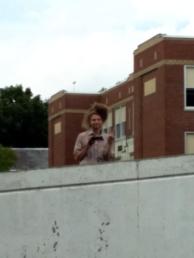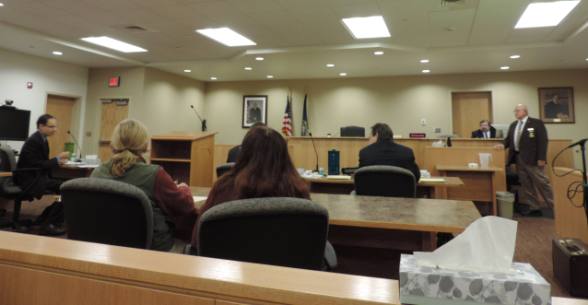Considerable time has passed since the city of Keene first filed a lawsuit against the meddlesome youths known as Robin Hooders. Following three days of testimonial hearings in October of 2013, a reunion party was hosted by the court for all initially involved, with three of six activists returning. Fine-tuning their excess to scale down the event significantly, the city would only present two witnesses, countered by two representing the defense, enabling what originally cost three days to wrap up within one.
The complications keeping the Robin Hood of Keene legal saga alive are as convoluted as the civil court system itself, which would have otherwise been unnavigable by the activists on defense if it were not for the appreciated representation by civil rights advocate attorney Jon Meyer. As the city’s attorneys began their case, Meyer declined to offer an opening statement, but instead asked if the city could clarify the specific demands it is seeking for “injunctive relief”.
Robert Dietel outlined that the CoK now requests no more than a ten foot “buffer zone” to float around parking enforcement officers. The request seemed modest compared to prior demands for 50, 30, and 20 feet of bureaucrat safety buffers. The tone of the day, echoing a sentiment expressed at the supreme court, seemed to be that the city’s attorneys would accept whatever “injunctive relief” they could be granted, anything to declare a small victory in what must be a loss of staggering proportions, both financially and politically.
Whether prior matters were capable of being addressed, city attorneys specified additionally that all testimony on the grounds for injunctive relief would be applicable only to events which occurred after October 2013, which was the conclusion of the similar hearing two years ago. Considering that all parties of the original suit are still named, one would have expected testimony to have suggested that all of the same characters were engaging in the same activities, but on the contrary, Keene’s parking enforcers stated that they have hardly, if ever, seen four of the six individuals named in the original suit since last appearing in court.
A good portion of the early testimony revolved around a video uploaded by Ian Freeman in which he and parking enforcer Lin loudly talk over each other as published to the internet from 2014. The distance Ian maintained from Lin was the focus of much speculation as the file was repeatedly played. While Lin described being annoyed by Ian on that occasion in the video, there was not any specific claims of offensiveness, wrongdoing, or even intentional antagonism by either of the parking enforcers against any of the individuals named in the suit. Parking enforcer Jane classified Garret as a ‘nuisance’ and daily stressor without specifying any instance of misbehavior during the span of relevant time. The enforcer recalled two instances which were cause for concern to her in recent memory. As she described each account, she went on to explain that neither instance involved anyone associated with Robin Hood of Keene. One involved a person she identified as J.P., the other was only described as an unidentified man. When asked if injunctive relief would satisfy the enforcers, they were reluctant to become enthused, and expressed an openly irrational disregard for the activist’s presence at any distance.
Part of the argument of the city is that the activities of activists is causing their parking enforcers to not be able to “do their job”. As part of her testimony, parking enforcer Lin presented partial “gap reports”, which consist of information logging the time and location of each expired meter violation written. While it is the job of parking enforcers to search for expired meter violations, it is not necessarily their job to find them, wherefore every meter in Keene could happen to be in compliance outside of the ticketing agent’s control. Lin indirectly acknowledged a sort of parking ticket quota placed upon her by bosses, as she stated that she must justify significant time gaps between tickets in the report, which led to the enforcers logging sightings of Robin Hooders within the reports.
Strangely enough, the partially prepared attorneys for the city presented incomplete gap reports, which had omitted information pertaining directly to times referenced in written annotations. Attorney Dietel rationalized that the city didn’t intend to show the physical data pertaining directly to what was being testified about, and instead that their intention was to share the incredibly vague written annotations, which were demonstrative of nothing substantive. Was it intentional obfuscation or shortsightedness that caused the city’s lawyers to neglect to include mathematical data to presumably support their claim? Is there a reason that the city would not want the public to know exactly how effective Robin Hooders have been at reducing the number of tickets being issued?
During the cross examinations of the two testifying Robin Hooders, city attorneys rehashed political and philosophical arguments raised in the original trial, demonstrating that the motivations of activists remains mostly unchanged. After calling on Garret to analyze the actions of Ian in his video, Ian was soon brought to the stand, provoking the moral ire of Charles Bauer. He asked Ian if he believed the parking enforcer’s jobs to be immoral, as though it were a condemnable personal position to hold. After receiving answers to his questions, Bauer spitefully appealed to the judge to “strike” the testimony and “compel” an alternative answer. Judge Kissinger rightly hesitated to compel any action, and endeavored well to restore proper decorum over the protests of the plaintiffs.
Rumors from what was overheard during bench conferences were that a mysterious individual named Matthew Phillips had filed a motion to intervene into the case. Allegedly, this person wished to be added to the list of defendants. The judge dismissed the motion(s) at this time, though the potential for the motion to be restored remains, as it is likely that the same person filing the motion was one of the two individuals testified to as causing significant concern to PEO Jane on April 11 of 2015.
Attorneys in this case have until October 19th to file additional statements of support or their position. The judge also requested ample study be applied to other cases in which courts have upheld floating buffer zones, which have predominantly only applied to fixed areas around women’s health clinics.
Not living up to the full measure of innocuous irrelevancy as they could have, the city unfortunately did not present any of the random photos and videos that they had included in a discovery package for the defense. In the packet were images of Ian and Garret walking around, as well as a video of Garret parking a bicycle at the City Hall bike rack. In the throes of pointlessness reached during this sort of lawsuit, one is reminded of the infinite imposition of energy consumption that the state is capable of, even such small and lesser-significant state organizations as the not so humble city of Keene.
Full video coverage of the court performance is now available at Fr33manTVraw. You can also check out this interview with Jon Meyer in which the defense attorney gives an update on the status of the case. You can also catch the story from the Keene Sentinel.



